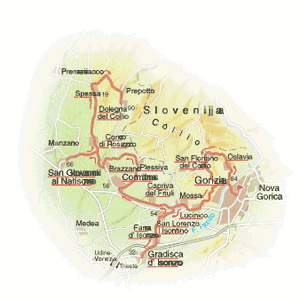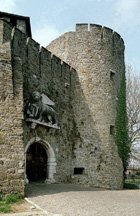On the slopes of Gorizia's hills, the Còllio
 The Cóllio Goriziano, usually simply called the Cóllio, is a series of hills on the border with Slovenia that enjoy the protection of the Julian Alps on the one hand and beneficial exposure to the climate of the Adriatic sea on the other. The vineyards are composed of marl and layers of Tertiary-period sandstone that used to lie under water, and provide terrain particularly suitable for the production of high quality wines. The wine route leaves from Gorizia, climbs up to San Floriano del Cóllio, then dips down to Gradisca d’Isonzo and climbs up again, through the vineyards, towards Cormòns and Dolegna del Cóllio.
The Cóllio Goriziano, usually simply called the Cóllio, is a series of hills on the border with Slovenia that enjoy the protection of the Julian Alps on the one hand and beneficial exposure to the climate of the Adriatic sea on the other. The vineyards are composed of marl and layers of Tertiary-period sandstone that used to lie under water, and provide terrain particularly suitable for the production of high quality wines. The wine route leaves from Gorizia, climbs up to San Floriano del Cóllio, then dips down to Gradisca d’Isonzo and climbs up again, through the vineyards, towards Cormòns and Dolegna del Cóllio.

Gorizia, a border city
The city of Gorizia lies on the River Isonzo and has very ancient origins. It was the capital city of a province of the old Austro-Hungarian Empire and flourished until the outbreak of the First World War, which reduced it to rubble. It was conquered by Italian troops in 1916, but it was not until 1947 that it finally became part of the Italian state, and then only the western part of the city. The eastern suburbs, the part now called Nova Goricia, were ceded to Jugoslavia and today lie in Slovenia. The centre of the old town is dominated by the castle, built sometime after 1000 AD by the Counts of Gorizia, and comprises houses, defensive walls and the castle itself. Two of the palazzi here are particularly interesting: the Palazzo dei Conti and the Palazzo degli Stati Provinciali, which now contain museums of furniture and furnishings, and numerous pictures by Friulan and Venetian artists. The Duomo (XIV century with numerous alterations) can be found in the Corte Sant’Ilario district. Inside, there are notable XV-century frescoes in the Gothic chapel of Sant’Acazio. Visit the Museum of History and Art in the Borgo Castello district to see collections of coins, prehistoric remains, Roman and pre-Roman archaeological finds, and a detailed display on the customs, arts and history of city life.
Gorizia
 There is also a First World War Museum, the Museo della Grande Guerra. The church of Sant’Ignazio in Piazza della Vittoria has some marble altars to admire. In front of the church, Neptune’s Fountain (la fontana di Nettuno) was made by Nicola Parnassi in the mid-XVIII century. Visit Palazzo Attems (XVIII century) in Piazza de Amicis for the Provincial Museum and its collection of Gorizian paintings, dating from the XVIII century to the present day.
There is also a First World War Museum, the Museo della Grande Guerra. The church of Sant’Ignazio in Piazza della Vittoria has some marble altars to admire. In front of the church, Neptune’s Fountain (la fontana di Nettuno) was made by Nicola Parnassi in the mid-XVIII century. Visit Palazzo Attems (XVIII century) in Piazza de Amicis for the Provincial Museum and its collection of Gorizian paintings, dating from the XVIII century to the present day.
The Military Memorial at Oslávia
Just north of Gorizia, Oslávia is famous for its white wines, and its plums, peaches and cherries. Oslávia is dominated by the Sacrario Militare memorial, which was built in 1938 and holds the remains of more than 57,000 soldiers killed in the First World War.
San Floriano del Cóllio
It is a short distance from Oslávia to San Floriano del Cóllio, one of the region’s most important wine centres. On top of San Floriano hill there is a XV-century castle, the property of the Barons Formentini since the middle of the XIX century. Of the mediaeval building, only a few stretches of wall, the north gate and two towers remain. Next to the castle, the Formentini winery and Wine Museum display viticultural artefacts and a specialist collection of books on wine.
La Serenissima di Gradisca d’Isonzo
The road goes downhill from San Floriano to the Isonzo plains and the town of Gradisca d’Isonzo. Here, in the Palazzo dei Provveditori, is the Friuli Regional Wine Centre, the Enoteca Regionale “La Serenissima”, with an exhibition of DOC wines from all over Friuli. Look out for the events in October held in the evenings that aim to match regional foods and wines. Gradisca began life as a fortified Venetian outpost in the struggle against the Turks. Piazza Unità d’Italia is its centre, and four parallel roads lead from it to the old town’s historic monuments. Palazzo Torriani is particularly worth a visit; now combining the functions of town hall and town library, it was built between 1644 and 1705 in a style similar to Palladio’s. The building also houses the Museo Civico (largely local history), and the Regional Contemporary Art Gallery, dedicated to the Gorizian painter Luigi Spazzapan, whose works can be admired inside together with other modern artists. The castle was built by the Venetians and then enlarged by the Austrian Habsburg dynasty, who imprisoned many Italian patriots in its dungeons. The Duomo is in Via Cesare Battisti; dedicated to Saints Peter and Paul, it has a Baroque façade, while the inside contains numerous works of art, including a XVI-century sarcophagus made by Nicolò della Torre.
Capriva del Friuli and its wineries
From Gradisca the road turns back towards the Cóllio hills until it comes to Capriva del Friuli. Capriva includes the sub-districts of Spessa, Russiz Inferiore, and Russiz Superiore. Its origins lie in the castle at Spessa and the villa at Russiz. The castle is a late XIX-century construction on the remains of much older XIII-century building. Today it is the headquarters of a winery whose cellars are located in an ex-First World War military bunker. Not far from the castle, Villa Russiz was built by the Counts La Tour, who introduced French grape varieties into Friuli. Just a few hundred metres away lies the Russiz Superiore property, built on the remains of an old castle; now it too is an important winery.
Cormòns and “Blind Beppe”
Not far from Gradisca is the town of Cormons, which was granted its charter in 1910 by Emperor Franz Josef, the man still called Checco Beppe, “Blind Beppe”, by its residents even today. On 18th August every year the anniversary of this charter is celebrated by Austrians, Slovenes and Italians alike, united by a sentimental attachment to the old Empire. The centre of the modern town of Cormòns is Piazza della Libertà, where there is a statue to one of Franz Josef’s predecessors, Emperor Maximilian I. Two roads lead from this piazza to the oldest part of the town. Here you can visit Palazzo Devetag, which houses the Town Library, and Palazzo Locatelli, the Municipio.
Cormòns
 The heart of old Cormons is Piazza XXIV Maggio, where the town market is held every Friday and where you can find the church of Sant’Adalberto, the Duomo. Inside, there are XVIII- century altars and some paintings by the Gorizian artist, Giuseppe Tominz.
The heart of old Cormons is Piazza XXIV Maggio, where the town market is held every Friday and where you can find the church of Sant’Adalberto, the Duomo. Inside, there are XVIII- century altars and some paintings by the Gorizian artist, Giuseppe Tominz.
Dolegna del Cóllio
The northernmost part of the Cóllio Gorizian hills is at Dolegna del Cóllio. The name Dolegna comes from the Slovene “dolenji”, or “low-lying place”. In fact, the town is in the curve of a hill that was once dominated by rival castles, either owned by the Patriarch of Aquileia or the Counts of Gorizia. Only Trussio Castle remains; and now, after repeated rebuilding over the ages, it has become a country residence and a famous restaurant.
|
THE PLEASURES OF THE TABLE |
|
| Marcundela | Pistum |
| A typical Friulan sausage made of pork chitterlings, liver, kidneys, fat and heart. Stuffed into a natural casing and then matured. The sausages are cut into pieces while still in their casing, fried in butter and then served with pasta or with a fried egg dish. | Gnocchi made of breadcrumbs mixed with sugar, eggs, herbs and raisins. Boiled and served in a pork broth. |
| Prosciutto cotto nel pane | Pane con la zucca |
| Local to the Gorizia area, this version of breaded ham is made with pork thighs coated in breadcrumbs to a depth of about one centimetre before baking in an old-fashioned or wood-burning oven until the crust is brown. Served hot, carved in slices, including the breadcrumb crust, and accompanied with grated horseradish. | Sweet pumpkin bread. The dough is made of flour, sugar, eggs, and clarified butter with the crucial addition of steamed and pulped pumpkin flesh and raisins. The cooked bread is sliced and eaten at breakfast or dunked in wine (try it with Traminer Aromatico or Verduzzo). |
|
THE WINE |
| The best wines of the region, mainly whites, originate from the hills that encircle the town of Gorizia and are famous for a softness and delicacy of pefume difficult to find anywhere else. It is from this area that Picolit originates, which has made Friuli-Venezia-Giulia famous worldwide. In Victorian times, it was a well-known and much appreciated wine and was to be found on the tables of aristocrats and monarchs throughout Europe. Named after the Picolit grape, this wine is the result of a process known in Italian as "acinellatura", an unique natural phenomenon whereby only some of the bunches of grapes reach complete maturity, resulting in grapes with a particularly high sugar content. Picolit is a golden-coloured dessert wine produced in exceedingly limited quantities with a fine, delicate and pleasing boquet. If you would like to prepare a lunch or dinner reminiscent of the area, click here to purchase wines carefully selected by our experts. |
|
EATING AND SLEEPING |
| For light meals, snacks and excellent wines, we recommend the "Enoteca di Cormòns" (tel. +39 0481630371) in Cormòns, situated in a delightful Liberty-style building on Piazza XXIV Maggio. The "enoteca" (or wine cellar) is run by Lucia who lays on beautifully prepared cold dishes. For hot dishes, try the "Al Ponte del Calvario" trattoria in Gorizia (tel. +39 0481534428) where you can try traditional local dishes such as "zikfri" (a type of pasta made from potato flour). For accomodation, we warmly recommend the "Castello di San Floriano" (tel. +39 0481884051) in the village of San Floriano del Còllio, a charming little hotel situated within the walls of an old fort. Every room in the hotel has the name of a wine. A good place to stay in Gorizia is "Alla Transalpina" (tel. +39 0481530291) situated in a characteristic old building with a charming garden. |








